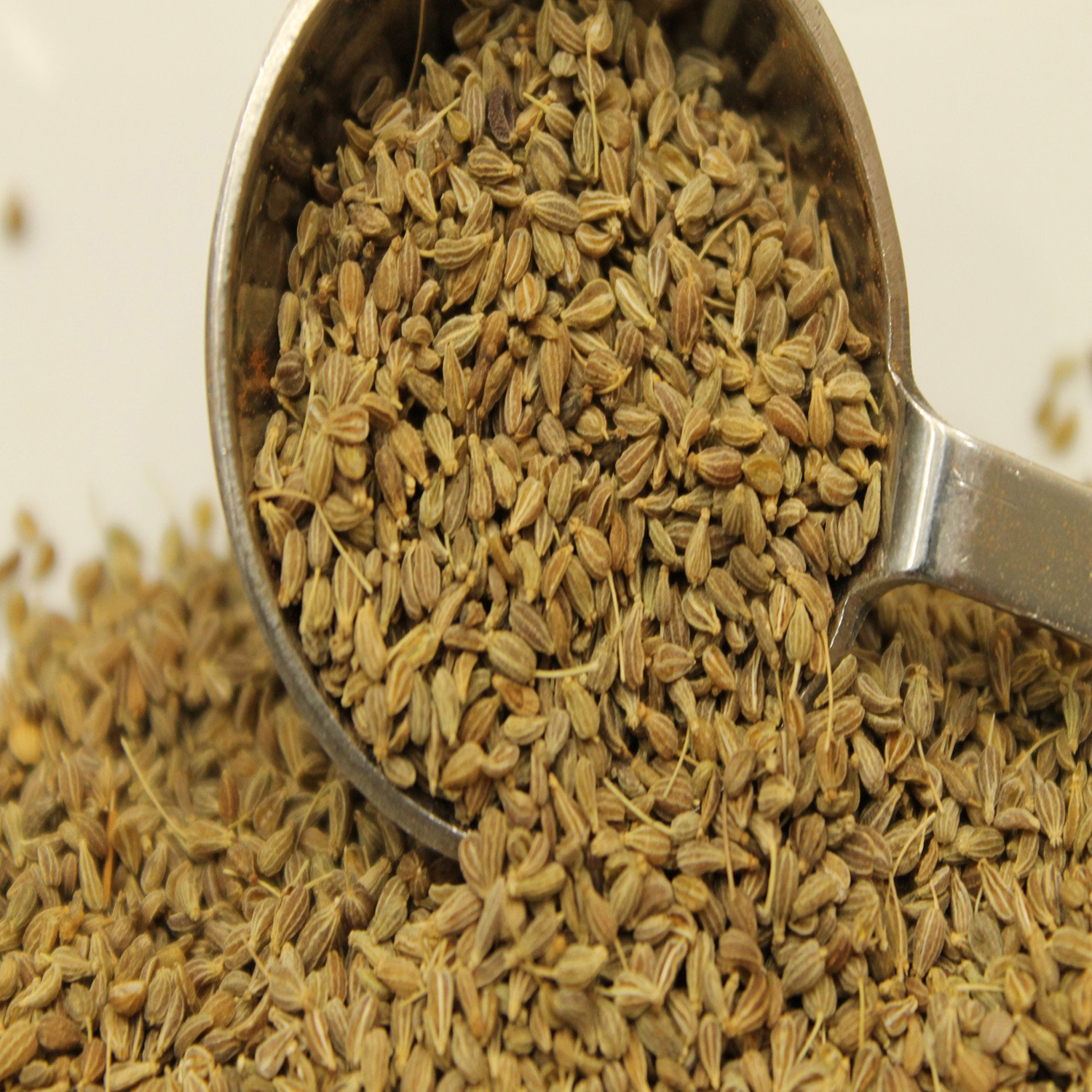Anise Pimpinella anisum Essential Oil
Login to view prices
Common name: Anise
Latin name: Pimpinella anisum L.
Family: Apiaceae (Umbelliferae)
Other names: Engl.: anise, anise burnet saxifrage, aniseed. Deu.: Anis. Suom.: anisruoho, anis. Sven.: anis. Fran.: anis, anis vert.
It should be differentiated from the so-called star anise, Illicum verum Hooker f. (fam. Magnoliaceae). It contains oils of similar chemical composition and, therefore similar odor flavor, and utilization. It is a small evergreen tree or bush, native to China.
Anise oil is sometimes adulterated with star anise oil, fennel oil, or synthetic anethole.
Anise-hyssop (Agastache foeniculum formerly Agastache anethiodora), is a perennial plant of the Lamiaceae family, native to the United States, which has a characteristic anise scent and flavor. Common names for this plant include Korean mint or anise mint.
Botanical Origin:
Common name: Anise
Latin name: Pimpinella anisum L.
Family: Apiaceae (Umbelliferae)
Other names: Engl.: anise, anise burnet saxifrage, aniseed. Deu.: Anis. Suom.: anisruoho, anis. Sven.: anis. Fran.: anis, anis vert.
It should be differentiated from the so-called star anise, Illicum verum Hooker f. (fam. Magnoliaceae). It contains oils of similar chemical composition and, therefore similar odor flavor, and utilization. It is a small evergreen tree or bush, native to China.
Anise oil is sometimes adulterated with star anise oil, fennel oil, or synthetic anethole.
Anise-hyssop (Agastache foeniculum formerly Agastache anethiodora), is a perennial plant of the Lamiaceae family, native to the United States, which has a characteristic anise scent and flavor. Common names for this plant include Korean mint or anise mint.
Description:
Anise, a native of the Orient, is a hapaxanthic annual herb, growing about 1 to 2 ft. high under cultivation. The greenish-gray, dried, ripe fruit, commercially called seed,tapers to a point,and varies in length from 2 to 5 mm.
Anise seed is a popular flavoring agent, widely employed in baked goods, confectionery, and liqueurs. The volatile oil can be recovered from the fruit (seed) by steam distillation. In many instances the oil has now replaced the seed for flavoring purposes.
Range & Habitat:
Anise, Pimpinella anisum L., is an herbaceous annual native to Egypt and to the Mediterranean region. It is cultivated in Europe (southern & southeastern Europe), Asia, India, Mexico, North Africa, India, and China.
The plant requires a warm and long frost-free growing season of at least 120 days -from planting to harvest- (the vegetative period of anise is long 130-140days). The reported life zone for anise production is 8 to 23°C.
The soil for Anise is a light; deep, well drained (friable), fertile or moderately rich, sandy loam is desirable for good growth of anise. The physical nature of the soil should be such that it lends itself well to pulverizing, yet retains moisture; then the small seed can be planted at a uniform depth, and cultivation of the small, young seedlings becomes feasible. A soil pH of 6.3 to 7.3 is desired. Anise appears to respond favorably to nitrogen fertilization by yielding a greater quantity of high-quality fruit.
Planting & Cultivation:
According to Stockberger, anise is grown from seed sown usually early in spring directly in the field in rows 2 to 3 feet apart. The seeds should not be more than 2 years old, are sown thickly, about two seeds to the inch (or a dozen to the feet), and covered half inch deep. Light cultivation is needed for weed control. The small white flowers bloom in midsummer (three months after planting), and seed maturation usually occurs one month after pollination, when the oil content in the dried fruit is about 2.5%.
Harvesting and Preparing for the Market:
In most anise producing countries the plants are pulled and stacked in the field to dry. In some cases the tops are cut off by hand, tied in bundles, and then stacked in conical piles with the fruiting heads toward the center so that the seeds continue to mature. As a rule, the plant is pulled or cut when all the seeds of the umbel are still green; then they may continue to mature after the bundles have been shocked with the seed ends toward the center. In this way considerable amount of seed continues to ripen, whereas those seeds that are mature do not discolor and shatter from the plant.
The plant may be pulled by hand piled, tops inward, in stacks about 6 ft. high, or they may be mowed and at once built up into cocks of the same height. After 4 to 5 days the seed will have ripened; it should then be threshed out, thoroughly cleaned, and bagged for the market.
As soon as the tips of the seeds turn a grayish-green color they should be harvested; when left exposed to the weather, they quickly turn brown or black.
Yield of seed per Acre:
Under favorable conditions, a yield of 400 to 600 lb. of seed per Acre may be expected.
Method of Extraction:
By Steam Distillation.
Like most seed material, anise seed should be crushed prior to distillation. Chernukhin found ground anise seed yields 5% more oil than whole seed does, and that with ground seed 10 to 15% less steam and 25% less time will be required for completion of the operation. The crushed seed must be distilled immediately to prevent any loss of oil by evaporation.
The volatile oil yield in anise seed varied from a minimum of 1.9 to a maximum of 3.1%, the average being 2.29% of oil.
Notes:
- It solidifies to a snow-white crystalline mass on cooling to 10°C, and it begins to liquefy at 15° or higher and completely liquefy at 19°C.
- The oil can be cooled considerably below its freezing-point without solidifying, and can be kept so for a long time if undisturbed. However slight agitation, or the introduction of a minute crystal of anethole, or a particle of dust sets up immediate solidification of the entire mass, with an appreciable rise in temperature.
- Since the congealing point of anise oil gives a good indication of the anethole content, it may be used for a rapid estimation of the percentage of anethole contained in the oil.
- Exposure of the oil to air for long periods causes polymerization and oxidation, with formation of anisic aldehyde, C8H8O2, and anisic acid; the solidifying point is lowered gradually (until finally it will no longer congeal), the specific gravity increases (in some cases to above 1.0), the refractive index is reduced and the oil becomes more soluble in 90% alcohol.
Adulteration & its Detection:
The oil is subject to much adulteration, especially with:
| Adulterant | Appropriate method for detection | Notes |
| Petroleum | The presence of 5 per cent. of petroleum, however, diminishes the solubility to 1 in 10 or more. | |
| Fennel oil | Will cause a change of the optical rotation; fennel being dextrorotatory. | The liquid portion of the oil produced during the manufacture of anethole, turpentine oil, alcohol, and fatty oils. |
| Star anise oil[1] | It is said that the two anise oils may be distinguished by treating with a saturated solution of HCl gas in absolute alcohol, the oil of P. Anisum yielding a blue coloration, and that of Illicium verum a yellow to brownish color, but the test does not appear to be entirely satisfactory. | Lower price and inferior to anise oil in odor (having a harsher odor), they can be compared by GC as both oils contain:
· Anethole. · Methyl chavicol. · Anisic acid & aldehyde. The star anise oil contains in addition: · d-pinene, · l-phellandrene, · hydroquinone ethyl ester. · and probably safrol |
| Synthetic anethole | we can identify this with gas chromatography by highlighting a number of constituents – the most prominent being cis-anethole, which occurs at about 0.2% to 0.4% in natural anethole and 2.3% in the synthetic variety. | Usually made from pine oil |
In general the best criterion of purity is the melting-point, which is usually about 17°.
N.B. Anise oil is sometimes used for adulteration of licorice essential oil.
The U. S. P. describes the oil as follows: Soluble in an equal volume of alcohol to a clear solution (absence of most fixed oils and oil of turpentine). This solution is neutral to litmus paper, and should not assume a blue or brownish color on the addition of a drop of ferric chloride T.S. (absence of some volatile oils containing phenols). When the oil is dropped into water, without agitation, it should not produce a milky turbidity (absence of alcohol)”—(U. S. P.)
[1] With a lower price which, according to the USP is considered “anise oil” yet strictly from the flavoring viewpoint, anise oil (Pimpinella anisum) is undoubtedly superior to star anise oil (the latter having a harsher odor).
Anise – Specific Uses and Applications
The major constituent in oil of anise is anethole. Methyl chavicol, anisal acetone and anisaldehyde are present at lower concentrations.
While the entire plant is fragrant, it is the fruit of anise, commercially called anise seed, that has been highly valued since antiquity. Anise fruit or oil find many applications:
- As a flavoring agent:
The delicate fragrance is widely used for flavoring curries, breads, soups, cakes, candies, desserts, non-alcoholic beverage, and liqueurs.
- Industrial applications:
The volatile or essential oil, obtained by steam distillation of the crushed anise seed, is valuable in
- perfumery and soaps
- toothpastes, mouthwashes(combined with the oils of gaultheria and peppermint), and skin creams.
- The oil is sometimes used as sensitizer for bleaching colors in photography.
- Medicinal applications:
As a medicinal plant, anise has been used as:
- aromatic carminative to relieve flatulence, and colic especially in infants,
- antiseptic,
- antispasmodic,
- mild expectorant,
- stimulant,
- stomachic,
- promote lactation in nursing mothers,
- medicine against bronchitis, indigestion,
- said to control lice and the ‘itch mite’ a cause of scabies.
- an ingredient in cough medicine and lozenges,
- It is reported to have diuretic and diaphoretic properties,
- Its warm and spicy scent has a comforting effect to the mind.
Blends well with:
Bay, cedarwood, dill, fennel, ginger, mandarin, petitgrain, peppermint, rosemary & spearmint.
Precautions:
A very potent oil not used in massage as skin sensitisation & irritation may occur.
Generally a stimulant but excessive use could cause sluggishness.
Avoid during pregnancy and during breast feeding.
If ingested in sufficient quantities, anise oil may induce nausea, vomiting, seizures, and pulmonary edema.
Anise and oil of anise are generally regarded as safe for human consumption as a spice/natural flavoring and plant/oil extract (21 CFR sections 182.10, 182.20 [1982]).
Export Markets:
We export our oils to many countries all over the world. USA, France, Germany, China, Malaysia, Algeria, Morocco, Indonesia…etc
Quotation:
- Incoterms: FOB Egypt or China
- Quantity: More than 200 L Minimum
- Specification: 100% natural and Pure quality
- Documentation: COA, MSDS, TDS, GC Peaks
- Packaging: Bulk in 180,60,25 liters Packs or retail packaging upon request
- Payment terms: TT in advance to Our bank account
- Lead time: Shipping through 10 days from receipt of the payment.
- Sea Shipping Time: 35 days
- Air shipping time: 10 days
Quality Certificates:
- ISO 9001-2015
- ISO 22000-2005
- GMP accredited by AQC Middle East FZE
- KOSHER Certificate
- Halal Certificate
- ORGANIC Certificate accredited by CERES GmbH Germany
- NOP Certificate accredited by CERES GmbH Germany
- Egyptian Ministry of Health Permission
Contact us please to receive other supporting documents for our Oils :
- COA
- MSDS
- TDS
- GC Peaks
Branding Services
We also can do customized packaging for you to bottle whatever size you like. We can help in designing labels, selecting good bottles, and packaging. We deliver integrated solutions under your brand..
Organically Certified Oil Available upon request
Additional information
| Weight | N/A |
|---|---|
| Dimensions | N/A |
| Oil Purity | 100% Natural & Pure without any chemical, flavor, food additive or carrier. |
| Ship from | China, Egypt |
| Country of Origin | China, Egypt |
| Cultivation Type | Organic Certified, Conventional |
| Oil Bulk Packaging | 180 kg Steel Drum, 25 kg HDPE Plastic Jerrycan, 50 kg HDPE Plastic drum |
| HS Code | 33012911 |
| CAS Number | 84775-42-8 |
| Oil Documentation Available | Allergen Free Certificate, Bovine Spongiform Encephalophathy (BSE) Certificate, Certificate of Analysis (COA), GMO Certificate, GRAS Status Statement, Halal Certificate, Herbal Origin Statement, KOSHER Certificate, Manufacturing Flow Chart, Material Safety Data Sheet (MSDS), Organic Certificate, Pesticide Residual Certificate, Researches & Studies, Technical Data Sheet (TDS), WADA Prohibited list Statement |
-
Login to view prices
-
Login to view prices
-
Login to view prices
-
Login to view prices
-
Login to view prices
Orange Infused Oil (Natural Orange peels or oil infused in Carrier Oil)
Login to view prices Read more









